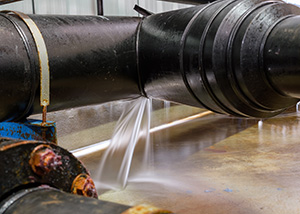Every second counts when it comes to accidental release of water. Knowing where shutoffs are located, and how to shut down water in the event of an emergency, can be the difference between wet vacuuming a small amount of water to shutting down an entire project and engaging in costly repairs.
What to do: Locate both domestic and fire sprinkler shutoffs prior to conducting work:
- Find main domestic shutoffs or isolating valves in the area you will be working.
- Locate sprinkler riser rooms and ensure they are unlocked and accessible.
- Check to make sure valves do not have secondary chains and padlocks.
- Identify key personnel who maintain keys to riser rooms and/or chained and padlocked valves. Save their contact information for quick access.
- Ensure key personnel are on premises and available in the event of a water emergency.
Why identifying water shutoff valves matters
Water damage can affect both large and small construction projects alike and has emerged as a major cause of loss on construction sites. Water damage losses can negatively impact contractors in multiple ways including project delays, liquidated damages, reputational risks, rework costs, etc.
For example, breaking a branch fire sprinkler line in an attic space could result in up to 500 gallons a minute being discharged into the building. Imagine the impact if you can’t find or access the sprinkler shut-off. By the time, the fire department arrives you could be responsible for millions of dollars in building damages and construction delays.
Illustrative Scenario: An HVAC contractor was hanging duct work for a tenant improvement in an office building. The scissor lift the installer was using accidentally hit and broke a fire sprinkler branch line at a coupling joint.
The installer did not know where the fire sprinkler riser room was located, so they had to contact the Superintendent for the General Contractor on the jobsite. The Superintendent located the riser room but did not have keys to access.
By the time the fire department arrived onsite to turn off the system, over $500,000 in damage was done and the project had to be shut down for an extended period-of-time.
